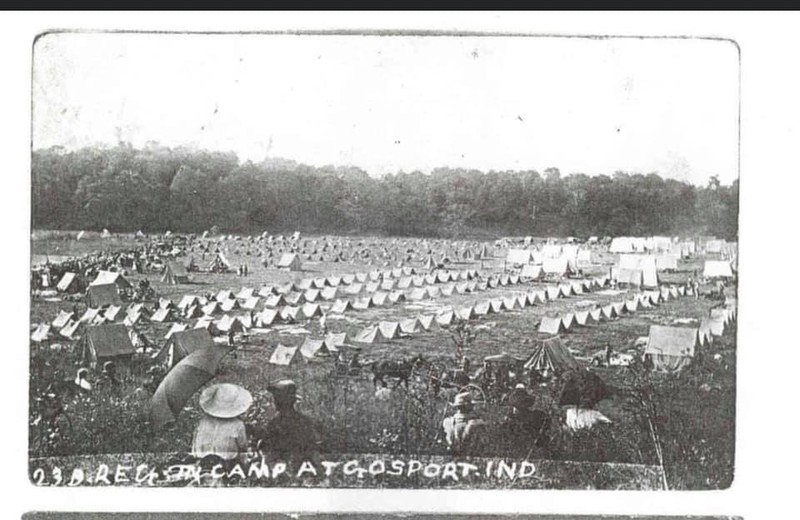Camp Hughes in Gosport, Indiana: 1861-1862
Introduction
Text-to-speech Audio
Images


Although this picture has been identified as being taken at the site of Camp Hughes in Gosport, Indiana, it remains unclear if it was taken in 1862 or during a later reenactment.

Backstory and Context
Text-to-speech Audio
Memorialization at Camp Hughes went through three phases. In 1923, a man named L. R. Gray erected a roughly cut block of granite at the site with the words “IN MEMORIAM Died in Camp Hughes –1861-2.” An article from the Gosport Reporter in that same year mentioned that Gray intended to have a plaque attached, but that did not happen until 2008. In the meantime, the Indiana Civil War Centennial Commission put up their own marker in 1963, which looks much like many of the historical markers present in Indiana today. It reads: “Civil War training camp for the 59th Indiana Volunteer Infantry in 1861-62 was located one-half mile southwest of Gosport on White River. Named for former Indiana Congressman James Hughes.” Then, in 2008, another group – consisting of Sons of Union Veterans of the Civil War, a VFW organization, and a Civil War reenactment group – finally attached a plaque to Gray’s granite block memorial. The final plaque lists the name of the 12 men who died, including the 8 buried nearby. The original 8 markers for the dead listed the men as “unknown,” but it remains unclear why. Using microfilm from the Indiana State Archives, their names were easily identified in 2008 for the final plaque.
In his application for disability pension after the Civil War, Lieutenant James W. Archer wrote that the people of Gosport had welcomed the sick soldiers into their own homes in order to provide them better shelter from the cold winter developing outside. Archer also spoke about his own efforts in caring for the sick, which he undertook due to having contracted the measles in childhood (thus making him immune). After training at Camp Hughes that winter, the 59th next travelled to New Albany to report for active duty. The fact that 12 men failed to leave the camp alive without having ever seen battle illustrates how disease often became an invisible enemy to both sides during the Civil War. Close quarters, poor hygiene and diet, and an underdeveloped comprehension of medicine often made disease an even greater threat than the enemy army.
Sources
Ben Harrison Camp No. 356. “Camp Hughes Plaque Dedicated at Gosport Cemetery, Gosport, IN.” Sons of Union Veterans of the Civil War. http://benharrisoncamp.org/camp-hughes-gosport-cemetery/. Accessed 20 Sept. 2020.
Indiana Historical Bureau. “Camp Hughes.” State Historical Markers. https://www.in.gov/history/markers/249.htm. Accessed 20 Sept. 2020.
Zollinger, Vivian. “‘I Take My Pen in Hand’: Civil War Letters from Owen County, Indiana, Soldiers.” Indiana Magazine of History, vol. 93, no. 2, 1997, pp. 111–196. JSTOR, www.jstor.org/stable/27792002. Accessed 20 Sept. 2020.
Melissa Meier, great-great granddaughter of Lt. James W. Archer (mentioned above)
